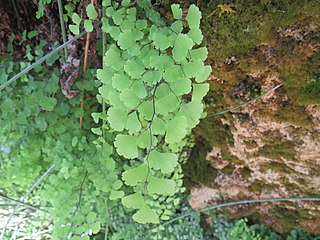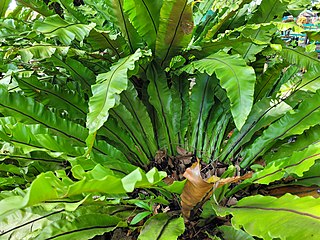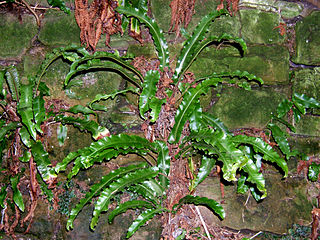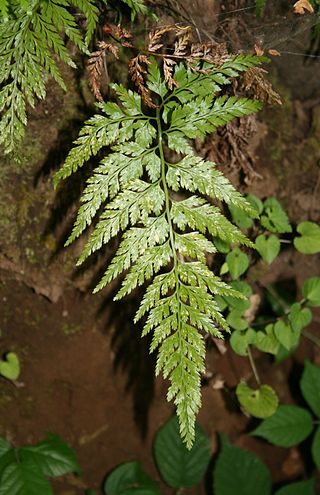
Asplenium is a genus of about 700 species of ferns, often treated as the only genus in the family Aspleniaceae, though other authors consider Hymenasplenium separate, based on molecular phylogenetic analysis of DNA sequences, a different chromosome count, and structural differences in the rhizomes. The type species for the genus is Asplenium marinum.

Adiantum capillus-veneris, the Southern maidenhair fern, black maidenhair fern, maidenhair fern, and venus hair fern, is a species of ferns in the genus Adiantum and the family Pteridaceae with a subcosmopolitan worldwide distribution. It is cultivated as a popular garden fern and houseplant.

Asplenium nidus is an epiphytic species of fern in the family Aspleniaceae, native to tropical southeastern Asia, eastern Australia, Hawaii, Polynesia, Christmas Island, India, and eastern Africa. It is known by the common names bird's-nest fern or simply nest fern.

Asplenium scolopendrium, commonly known as the hart's-tongue fern, is an evergreen fern in the family Aspleniaceae native to the Northern Hemisphere.

Adiantum aleuticum, the western maidenhair fern or Aleutian maidenhair, is a species of deciduous fern in the genus Adiantum.

Empetrum nigrum, crowberry, black crowberry, or, in western Alaska, blackberry, is a flowering plant species in the heather family Ericaceae with a near circumboreal distribution in the Northern Hemisphere. It is usually dioecious, but there is a bisexual tetraploid subspecies, Empetrum nigrum subsp. hermaphroditum, which occurs in more northerly locations and at higher altitude.

Asplenium rhizophyllum, the (American) walking fern, is a frequently-occurring fern native to North America. It is a close relative of Asplenium ruprechtii which is found in East Asia and also goes by the common name of "walking fern".

Ribes aureum, known by the common names golden currant, clove currant, pruterberry and buffalo currant, is a species of flowering plant in the genus Ribes native to North America.

Asplenium septentrionale is a species of fern known by the common names northern spleenwort and forked spleenwort. It is native to Europe, Asia and western North America, where it grows on rocks. Its long, slender leaves give it a distinctive appearance. Three subspecies exist, corresponding to a tetraploid and a diploid cytotype and their triploid hybrid.

Asplenium montanum, commonly known as the mountain spleenwort, is a small fern endemic to the eastern United States. It is found primarily in the Appalachian Mountains from Vermont to Alabama, with a few isolated populations in the Ozarks and in the Ohio Valley. It grows in small crevices in sandstone cliffs with highly acid soil, where it is usually the only vascular plant occupying that ecological niche. It can be recognized by its tufts of dark blue-green, highly divided leaves. The species was first described in 1810 by the botanist Carl Ludwig Willdenow. No subspecies have been described, although a discolored and highly dissected form was reported from the Shawangunk Mountains in 1974. Asplenium montanum is a diploid member of the "Appalachian Asplenium complex," a group of spleenwort species and hybrids which have formed by reticulate evolution. Members of the complex descended from A. montanum are among the few other vascular plants that can tolerate its typical habitat.

Asplenium bradleyi, commonly known as Bradley's spleenwort or cliff spleenwort, is a rare epipetric fern of east-central North America. Named after Professor Frank Howe Bradley, who first collected it in Tennessee, it may be found infrequently throughout much of the Appalachian Mountains, the Ozarks, and the Ouachita Mountains, growing in small crevices on exposed sandstone cliffs. The species originated as a hybrid between mountain spleenwort and ebony spleenwort ; A. bradleyi originated when that sterile diploid hybrid underwent chromosome doubling to become a fertile tetraploid, a phenomenon known as allopolyploidy. Studies indicate that the present population of Bradley's spleenwort arose from several independent doublings of sterile diploid hybrids. A. bradleyi can also form sterile hybrids with several other spleenworts.

Asplenium adiantum-nigrum is a common species of fern known by the common name black spleenwort. It is found mostly in Africa, Europe, and Eurasia, but is also native to a few locales in Mexico and the United States.

Asplenium onopteris, known as the Irish spleenwort or western black spleenwort, is a species of fern mostly found throughout the Mediterranean Basin but also around the Eastern Atlantic.

Asplenium × ebenoides is a hybrid fern native to eastern North America, part of the "Appalachian Asplenium complex" of related hybrids. The sterile offspring of the walking fern (A. rhizophyllum) and the ebony spleenwort (A. platyneuron), A. × ebenoides is intermediate in morphology between its two parents, combining the long, narrow blade of A. rhizophyllum with a dark stem and lobes or pinnae similar to those of A. platyneuron. While A. × ebenoides is generally sterile, fertile specimens with double the number of chromosomes are known from Havana Glen, Alabama. These fertile allotetraploids were reclassified as a separate species named A. tutwilerae in 2007, retaining the name A. × ebenoides for the sterile diploids only.

Minerva's Garden is located in the heart of the old town of Salerno, in a zone known as the "Plaium montis" in the Middle Ages. It is halfway along an ideal route that runs along the axis of the walled and terraced vegetable gardens, climbing from the Municipal Park, near the river Fusandola, towards the Arechi Castle.
Asplenium arcanum is a fern known from western Mexico and Nicaragua.
Purwodadi Botanical Garden is a research centre in Purwodadi, Pasuruan, East Java, Indonesia. It has an area of 85 hectares and more than 10,000 types of trees and many plant collections. Callus cultures of Agave amaniensis by Setia Dewi were taken in 1988.














